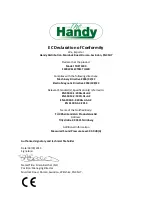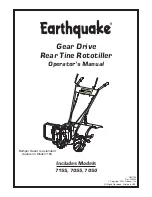
OPERATION
Before operating the machine, please ensure you are fully aware of the below instructions, failure
to do so, could invalidate your manufacturer’s warranty. Completely unwind the electrical cable.
ADJUSTING THE SPUR
The position of the spur defines the working depth.
(Image 4)
Press the button to release the frame of wheels. Lift the wheel up until the lock piece engages
into the recess on the other side of the frame. Release the button and make sure the frame is
locked firmly.
Image A - Use this position for transportation.
Press the button to release the frame of wheels. Pull the wheel down until the lock piece
engages into the recess on the other side of the frame. Release the button and make sure the
frame is locked firmly.
Image B - Use this position for working.
STARTING
Image 6
Use your thumb to press the safety button (I) on the left side of the right handle and then press
the operation switch (II).
The safety button is only used as a release, so that the motor can be started and does not have
to be depressed, once the motor has been started.
To turn the motor off, simply release the operation switch (II).
TIPS DURING OPERATION
Use the tiller for breaking sod, preparing seedbeds, and for cultivating gardens and flower beds.
The tiller may also be used to dig small holes for planting saplings or potted plants.
Move the appliance to the work area prior to starting the motor.
Hold the appliance firmly, adjust the spur into the ground and raise the appliance and switch on
the motor at no load.
Press down on the handles until the appliance has dug to the depth required and then apply only
sufficient pressure to maintain that depth.
The tines will pull the tiller forward during operation.
For deeper digging, best results can be achieved by several movements, especially when the
ground is very hard or rough.
By pulling tiller back towards yourself, the tines will dig deeper and more aggressively.
For breaking sod or deep tilling, allow the tines to pull the tiller forward to the end of your arm’s
reach, firmly pull the tiller back towards you. By repeatedly allowing the tiller to move forward
and then pulling back to you, the tiller will be most effective.
If the tiller digs deep enough to stay in one spot, gently rock the tiller side to side to start the
tiller moving forward again.
For preparing a seed bed, we recommend you apply one of the tilling patterns shown in
Image 7
.
A
– Make two passes over the area to be tilled, the second at a right angle to the first.
B
– Make two passes over the area to be tilled, the second overlapping the first.
To prevent tripping take particular care when moving backwards and when pulling the tiller.
Always let the tines rotate at top speed; do not work in such a way as to overload the appliance.
Never pass the tiller over the extension cord; make sure the cord is always in a safe position
behind your back.
Tilling only when it is suitable. Frozen or waterlogged ground, if cultivated, can cause poor soil
moisture movement.
When working on inclines, always stand diagonally to the incline in a sturdy, safe stance. Do not
work on extremely steep slopes.







































